Understanding the Cost of a Carat and a Half Diamond
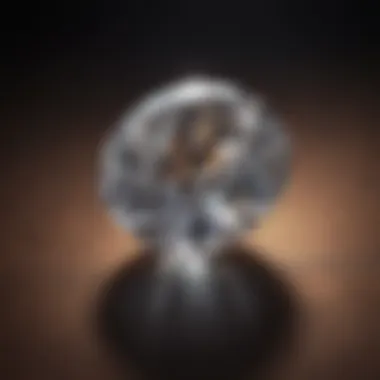
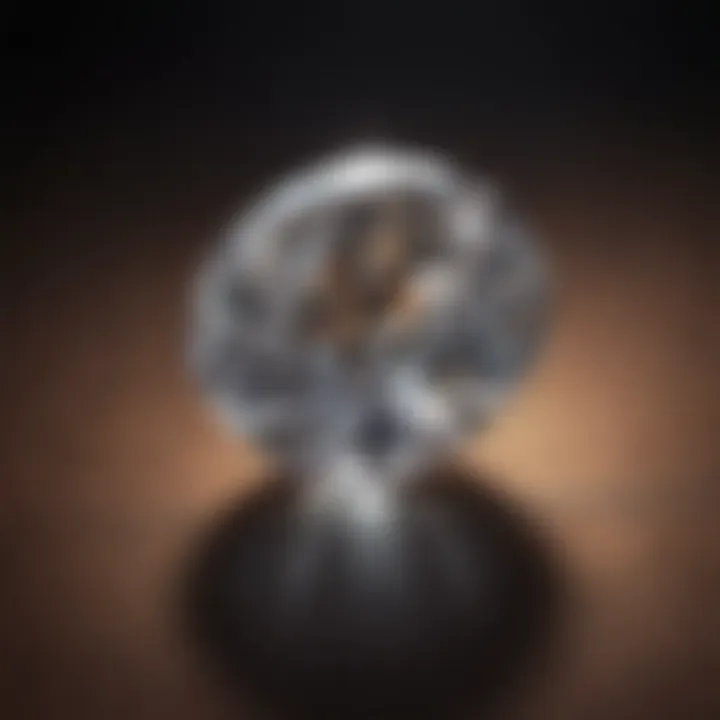
Intro
Gemstone Overview
Definition of Gemstones
Gemstones are precious or semi-precious minerals, rocks, or organic materials that are cut and polished for use in jewelry or decorative arts. Their beauty, rarity, and structural integrity make them attractive to many. Diamonds, being one of the hardest substances known, hold a special place within this category, often symbolizing love and commitment.
Classification of Gemstones
Gemstones are typically classified into two broad categories: precious and semi-precious.
- Precious Gemstones include diamonds, emeralds, rubies, and sapphires. These gems are highly sought after due to their rarity and aesthetic appeal.
- Semi-Precious Gemstones encompass a wider variety including amethyst, garnet, and topaz. While they are often more abundant, they also possess unique characteristics that appeal to collectors.
Every type of gemstone is graded based on specific criteria, including color, clarity, cut, and carat weight. Understanding these parameters is crucial, particularly when evaluating diamonds.
Historical Significance
Origins of Gemstone Use
The use of gemstones dates back thousands of years. Early civilizations valued gems not only for their beauty but also for their perceived spiritual and healing properties. Diamonds, in particular, were believed to possess protective qualities, making them highly coveted.
Cultural Insights: Gemstones in Ancient Civilizations
Gemstones played various roles in ancient cultures. For instance, in Ancient Egypt, stones like lapis lazuli were believed to facilitate communication with the divine. Meanwhile, in India, diamonds were associated with wealth and power, often adorning the crowns of royalty.
"The history of gemstones is as rich as the stones themselves, intertwining art, culture, and tradition across the globe."
As societies evolved, so did the significance of gemstones. Diamonds became synonymous with status and attraction, thus driving their demand over the centuries.
Finale
With the exploration of gemstones in context, it becomes evident that a carat and a half diamond embodies more than just its weight. It is a fusion of history, culture, and intricate valuation criteria. This sets a foundation for comprehending the cost and nuances that accompany diamond purchasing decisions.
Prologue to Diamond Pricing
Understanding diamond pricing is crucial for anyone considering a diamond purchase, especially when it comes to a carat and a half diamond. This size of diamond strikes a balance between visible presence and manageability in price. Buyers should equip themselves with knowledge about how diamonds are valued to make informed choices that reflect both personal taste and budget.
In this context, the carat weight serves as a significant factor but is not the only element at play in determining price. Buyers need to consider various aspects that affect value and desirability.
The Importance of Carat Weight
Carat weight is often seen as the primary determinant of a diamond's price. One carat is equal to 0.2 grams, and as the weight increases, so does the price exponentially. A carat and a half diamond offers a larger look without the often prohibitive costs associated with heavier stones. Understanding how carat weight interacts with market trends is essential for buyers.
This often leads purchasers to believe that a higher carat weight directly corresponds to a better quality diamond. However, this is a simplification. Factors such as cut, color, and clarity also contribute significantly to a diamond’s overall value.
Role of the Four Cs
To fully appreciate how pricing is established, one must dive deep into the Four Cs of diamonds: Cut, Color, Clarity, and Carat. Each of these elements plays a vital role in the appraisal of a diamond and should be considered holistically rather than in isolation.
Cut
The cut of a diamond influences its brilliance and overall appearance. A well-cut diamond refracts light beautifully, making it appear more vivid and appealing. The specifics of the cut, including proportion and polish, can enhance or detract from its overall value. A diamond with an Excellent cut grade is often sought after for its stunning visual appeal.
While it might seem intuitive to focus on carat weight, neglecting the cut could mean sacrificing quality for quantity. Therefore, when assessing a 1.5 carat diamond, understanding the cut can be as important as the weight itself.
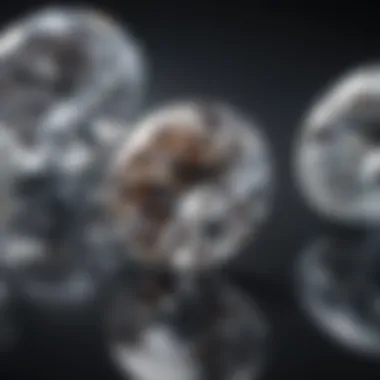
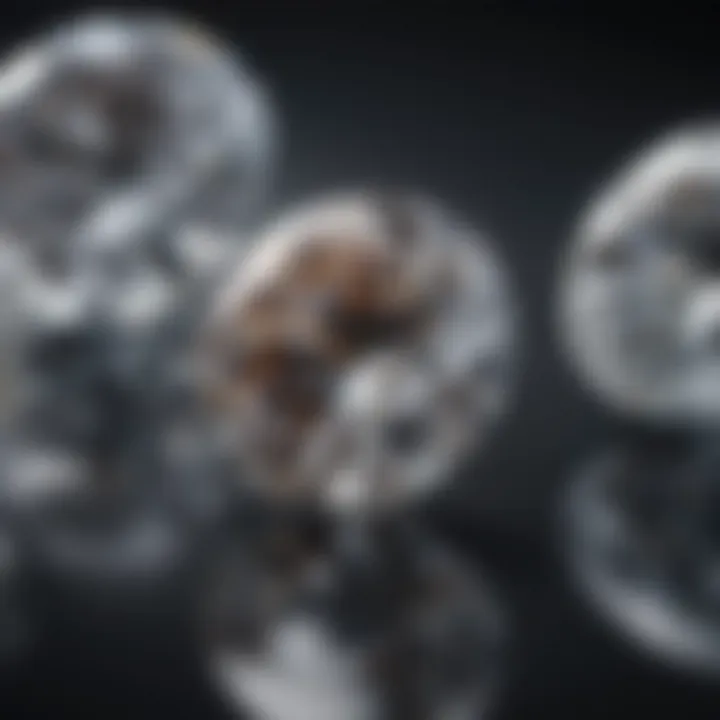
Color
Color grading ranges from colorless to light yellow or brown. Colorless diamonds are typically more valuable. A diamond in the D to F range is highly coveted and encounters less price depreciation. When it comes to a carat and a half diamond, the desired color can provide both aesthetic pleasure and investment value.
Choosing a diamond that balances quality in cut with acceptable color can lead to significant savings without compromising on visual allure. A careful assessment of the color can yield options that maintain excellent value at varied price points.
Clarity
Clarity refers to the presence of inclusions or blemishes within a diamond. This aspect greatly affects valuation. Higher clarity ratings, such as IF or VVS, indicate fewer visible imperfections and are more sought after, but they can also come with a steeper price tag. An understanding of clarity grades is crucial, as some inclusions may be microscopic and not noticeable to the naked eye.
Balancing clarity with other factors, buyers may find diamonds that excellently represent value for money at a carat and half. Consideration of clarity can open doors to finding visually appealing diamonds that also fit within budget constraints.
Carat
As previously stated, carat weight signifies the size of the diamond itself. A carat and a half diamond can provide an impressive visual impact while remaining comparatively affordable. However, it's essential to be mindful that once you surpass certain weight thresholds, prices increase dramatically due to rarity.
Thus, when selecting a diamond, one should focus on the balance between size, quality, and personal preference. With careful research and understanding of carat implications, buyers can identify opportunities where they get both size and quality at reasonable price points.
Current Market Trends
Understanding current market trends is crucial for anyone interested in the valuation of a carat and a half diamond. Market fluctuations can greatly influence pricing, making it essential for buyers and sellers to stay informed. By recognizing these trends, one can make better decisions, whether this involves purchasing, selling, or investment strategies.
Demand and Supply Dynamics
Demand and supply play a central role in determining the cost of diamonds, including those of a carat and a half. When demand rises—whether due to market trends or social factors—prices tend to increase. Notably, more people show interest in diamonds during celebrations such as engagements and anniversaries. Thus, understanding these cycles helps buyers anticipate price changes.
Several factors influence demand:
- Cultural significance: Diamonds hold a special position in engagements and weddings across many cultures.
- Celebrity endorsements: Public figures often set trends, increasing interest in certain diamond styles.
- Economic factors: In times of economic growth, consumers are more willing to spend on luxury items.
On the other hand, supply dynamics can shift due to mining limitations, production costs, and geopolitical issues. Factors such as natural disasters, labor issues, or regulatory changes can restrict supply, driving prices up further.
Pricing Influences from Global Events
Global events have an unpredictable influence on diamond pricing. Political instability in diamond-producing regions, for instance, can lead to supply constraints, affecting availability. This can cause significant price spikes for diamonds, including those around the weight of a carat and a half.
Key global factors include:
- Economic downturns: Generally, luxury goods see an initial drop in demand during tough economic periods. However, once the economy stabilizes, renewed demand can result in a price surge.
- International trade policies: Tariffs and trade agreements directly influence the cost of imported diamonds, thus affecting their overall price in different markets.
- Natural disasters: When major diamond mines face interruptions due to earthquakes or floods, this can immediately affect the supply chain.
"A thorough understanding of supply and demand, combined with awareness of global events, lays the groundwork for informed decisions in diamond transactions."
In summary, keeping abreast of current market trends, including demand and supply dynamics along with global events, enables potential buyers to make decisions that reflect both their budget and market conditions. By analyzing these elements, one can navigate the complexities in the diamond market more effectively.
Cost Analysis of Carat and a Half Diamonds
Understanding the cost analysis of a carat and a half diamond is crucial for buyers looking to invest in quality gemstones. This section breaks down how various factors contribute to the overall price, empowering consumers to make informed decisions. Analysis of cost involves examining aspects such as average pricing, comparisons with other carat weights, and the effect of quality factors. Recognizing these elements can lead to a more strategic purchase and adequate budgeting.
Average Price Range
The average price range for carat and a half diamonds typically falls between certain values, which reflect both market conditions and the characteristics of the diamond itself. Generally, these diamonds can range from $3,000 to upwards of $10,000, depending on their quality attributes. Factors such as cut quality, color grade, and clarity play a significant role in determining these prices.
When purchasing, it is advisable to gather multiple estimates to assess the market range effectively. Understand how to compare various qualities to identify diamonds that provide good value for their cost. Moreover, prices can fluctuate based on market demand, so keeping an eye on current trends is also important for prospective buyers.
Comparison with Other Carat Weights
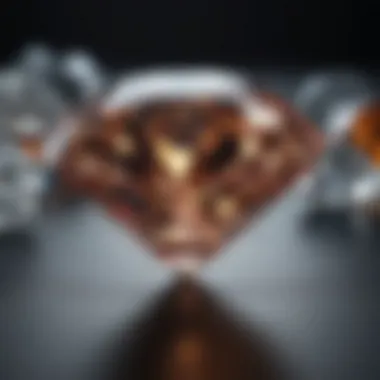
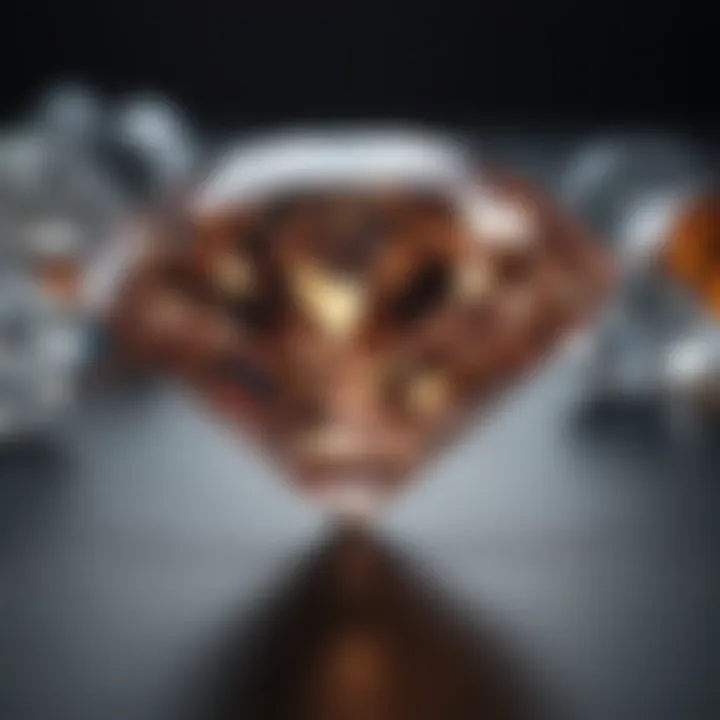
Comparing a carat and a half diamond with other weights provides context for understanding its value and significance in the jewelry market.
One Carat
One carat diamonds are among the most popular choices in the market. They are often seen as a benchmark for quality and affordability. The typical price range for a one carat diamond is from $2,000 to $7,000, making them accessible for a wider range of buyers. The key characteristic that makes one carat appealing is that they offer a fantastic balance between size and price. A one carat diamond can be noticed easily without the steep price tag of larger diamonds. However, buyers do need to consider the specific qualities of each diamond to ensure they find one that meets their standards.
Two Carats
Two carat diamonds represent a significant step up in both size and price. The cost for a two carat diamond can range from $8,000 to $20,000. The primary attribute that sets two carats apart is their impressive visual impact. They can serve as a statement piece or a symbol of commitment. However, this size often requires a more careful selection process as clarity and cut become even more critical at this weight. While they carry a hefty price, their overall presence can make the investment worthwhile, as they tend to hold their value better over time compared to smaller options.
Quality Considerations
Understanding quality considerations is crucial for anyone looking to purchase a carat and a half diamond. Quality encompasses several factors that can heavily influence the diamond's final price and value. Notably, buyers should pay attention to cut, color grading, and clarity levels. Each element serves not just as a measurement of quality, but also as an indicator of the diamond's overall appearance and desirability. When one comprehends these factors, it significantly enhances their decision-making process.
Impact of Diamond Cut on Pricing
The cut of a diamond is perhaps the most significant factor influencing its price. It refers to how well a diamond has been shaped and faceted. An excellent cut maximizes the stone's brilliance and fire, making it visually appealing. Diamonds with higher cut grades tend to command higher prices because they reflect light more effectively. A poorly cut diamond may appear dull, regardless of size or color. As such, buyers should prioritize cut quality when shopping for a carat and a half diamond. Look for terms like "Ideal" or "Excellent" on grading reports. These cuts assure optimal light performance and value.
Color Grading's Influence
Color grading is another essential aspect of diamond quality. Diamonds are graded on a scale from D (colorless) to Z (light yellow or brown). Color may seem subtle, but it significantly affects pricing. A high-quality carat and a half diamond should generally be in the G to J range for optimal beauty without escalating prices excessively. Diamonds graded as D, E, or F usually exhibit no discernible color, making them among the most coveted options. Buyers should ensure they evaluate color in natural light to perceive true coloring.
Clarity Levels and Their Cost Implications
Clarity levels pertain to the presence of inclusions and blemishes within the diamond. The Gemological Institute of America (GIA) and other grading bodies categorize diamonds based on clarity from Flawless to Included. A carat and a half diamond with higher clarity ratings—like VVS and VS—tends to be more valuable. Inclusions can be microscopic, but with high magnification, they become apparent. This can impact the diamond's allure and, subsequently, its price. Buyers should inspect diamonds carefully to avoid paying for flaws that may compromise beauty.
"Understanding the intricacies of a diamond's quality factors not only aids in proper valuation but also enriches the overall purchasing experience."
In summary, quality considerations play a vital role in shaping the cost of a carat and a half diamond. Buyers equipped with knowledge about cut, color, and clarity are better positioned to make sound investments in their choices.
Buying Considerations for Consumers
When purchasing a carat and a half diamond, potential buyers face several important factors to consider. These elements guide consumers in making educated decisions that align with their preferences and financial capacity. The purchasing process can be complex, involving not just the diamond itself but also various other aspects that can influence overall satisfaction and value.
Choosing Between Natural and Lab-Grown Diamonds
One significant consideration is whether to select a natural or a lab-grown diamond. Natural diamonds form over millions of years under intense pressure and heat, resulting in unique characteristics and intrinsic value. However, lab-grown diamonds, created in controlled environments, offer a more ethical and often more affordable option.
Consumers should weigh the following:
- Ethical considerations: Lab-grown diamonds often present a more sustainable alternative, minimizing environmental impact and avoiding the ethical concerns associated with some natural diamond mining operations.
- Cost differences: Generally, lab-grown diamonds can be 20-40% less expensive than their natural counterparts, allowing consumers to purchase a larger or higher-quality stone for the same budget.
- Long-term value: While natural diamonds usually retain their resale value better, lab-grown diamonds may depreciate faster, which is something to keep in mind as you consider future needs.
Both options have their merits, and understanding what matters most to you is crucial.
Setting a Budget for Purchase
Another vital element is establishing a budget for the diamond purchase. A well-defined budget can streamline the buying process and reduce unnecessary stress. Various costs should be considered when planning the budget:
- Diamond cost: Naturally, the price of the diamond will be significant. This includes not just the carat weight but also factors like cut, color, and clarity which also influence price.
- Setting expenses: The choice of jewelry setting will impact the overall cost. Different materials such as platinum, white gold, or yellow gold will affect the final price.
- Insurance and appraisals: Protecting your investment is key. Insurance should be part of your budget to safeguard against loss or damage. Appraisal costs can also add to initial expenses, as professional evaluations may be necessary for insurance coverage purposes.
- Aftercare: Consider future costs for maintenance and cleaning. Regular care ensures the longevity of the diamond and its setting, which can lead to additional expenses down the line.
Ultimately, establishing a budget that considers all these aspects helps enhance your experience and ensures you remain within expected financial limits while purchasing the diamond.
Additional Costs Beyond the Diamond
When considering the purchase of a carat and a half diamond, it is crucial to understand that the cost extends beyond the diamond itself. Many buyers focus solely on the diamond's purchase price, overlooking the additional expenses that come with it. This oversight can lead to unexpected financial burdens that may arise at later stages of ownership. Understanding these additional costs can aid buyers in making more informed decisions and ensuring that they fully appreciate the total investment required.
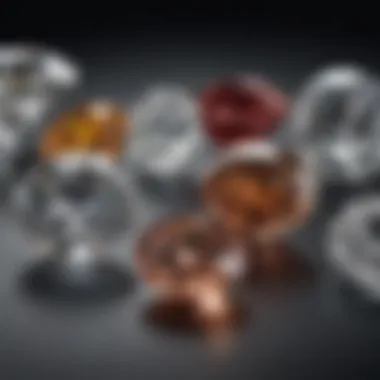

Jewelry Setting Options
The choice of jewelry setting plays a significant role in the overall cost of a diamond. Setting a diamond into a piece of jewelry not only elevates its appearance but also influences its protection and durability. Various options include solitaire settings, halo settings, and three-stone settings, each varying in price and style.
- Solitaire Settings: Often more affordable, these settings emphasize the diamond itself. A classic choice for engagement rings, they typically do not include many extra materials.
- Halo Settings: These settings feature smaller diamonds surrounding the center stone, increasing visual impact. However, they can be more expensive due to the added stones and complexity of the design.
- Three-Stone Settings: This style represents the past, present, and future. They can be pricier due to the additional diamonds needed for the design.
When choosing a setting, it's essential to balance aesthetic preferences with budget constraints. Careful consideration of the design and craftsmanship can prevent overspending.
Insurance and Appraisal Costs
Insurance for your diamond is an often-overlooked cost that can protect your investment. Diamonds are valuable, and ensuring protection in case of loss, theft, or damage is critical. Insurance premiums will vary based on the diamond’s value, location, and coverage options. Obtaining such insurance requires an appraisal to establish the diamond's market value.
- Importance of Appraisal: An appraisal is a written document from a professional gemologist that asserts the diamond's value. It serves various purposes, including validating insurance claims and aiding in reselling procedures. Understanding the appraisal process can often lead to a clearer comprehension of the diamond's worth.
- Continuous Costs: Maintaining insurance over the years adds to the total costs. Buyers should also be prepared for possible increases in premiums as the diamond market continues to change.
In summary, when purchasing a carat and a half diamond, remember that additional costs related to the setting and ongoing insurances are essential factors impacting the total investment. Ignoring these costs may result in financial strain down the line. Thus, proper planning and resource allocation are vital for a satisfying purchase role in the diamond's lifecycle.
"Understanding all dimensions of diamond expenses ensures a holistic view of your investment."
The Role of Certification
Certification plays a crucial role in the diamond industry, particularly for those considering the purchase of a carat and a half diamond. Certificates serve as a guarantee of quality, providing an in-depth analysis of a diamond's attributes. This verification is important because it simplifies the buying process for consumers. With many options available in the market, having a certified diamond helps potential buyers feel more confident in their investment.
Formal certifications usually come from reputable gemological laboratories. These organizations rigorously assess each diamond based on the Four Cs: Cut, Color, Clarity, and Carat weight. A trustworthy certification ensures that the information is accurate and reflects the true value of the diamond.
Understanding certifications also aids in making better comparisons between different diamonds. When a buyer understands what each certification entails, they can easily evaluate which diamond offers better value for their needs.
Importance of GIA and AGS Certifications
The Gemological Institute of America (GIA) and the American Gem Society (AGS) are two of the most respected certifying bodies in the industry. Diamonds graded by these institutions are often viewed as more credible. The GIA has set the standard for diamond grading, being one of the pioneers in developing a uniform grading system.
Similarly, AGS utilizes a comprehensive grading method, which involves meticulous evaluation of the diamond’s light performance among other factors.
Certifications from GIA and AGS not only offer assurance but also contribute to a diamond’s resale value. A diamond with a GIA or AGS certification can demand higher prices compared to ungraded or lower-standard certified diamonds due to their recognized credibility.
How Certification Affects Value
The presence of a certification significantly affects a diamond's value. When comparing two diamonds of similar weight but differing certifications, the one with a GIA or AGS certification typically holds a premium price. This price difference stems from several factors:
- Trust and Transparency: Certified diamonds come with a guarantee that the described quality is accurate, promoting buyer confidence.
- Market Demand: Consumers are often willing to pay more for certified diamonds because they perceive them as more valuable and trustworthy.
- Resale Potential: Diamonds with established certifications maintain value better than non-certified stones. This is crucial for those considering their purchase as an investment.
"The certification of diamonds transforms an abstract market into a structured platform where informed decisions can be made."
In summary, certification is not just a piece of paper but a vital aspect that influences a diamond's worth. Buyers should prioritize acquiring diamonds with reputable certifications to ensure they are making a secure and informed investment.
The End
The conclusion of this article plays a crucial role in encapsulating the extensive analysis of the factors affecting the cost of a carat and a half diamond. Understanding this topic is vital not only for potential buyers but also for gemstone enthusiasts and collectors. By synthesizing the information presented, readers gain a clearer insight into how various elements influence valuation, enabling them to make better-informed decisions in their purchasing journeys.
Summarizing Key Takeaways
- Value and Cost Relationship: Carat weight directly impacts the diamond's price, but it is not the only determining factor. Quality elements like cut, color, and clarity also bear significant weight in the valuation process.
- Market Trends: The dynamics of supply and demand play a critical role in pricing. Global events can shift these factors dramatically affecting costs.
- Certification Matter: The importance of independent certifications from recognized institutions like GIA and AGS cannot be overstated. These certificates authenticate the diamond’s quality and can influence resale value.
- Additional Costs: Purchasing a diamond is not just about the stone itself. Costs for settings, insurance, and potential appraisal should be included in the overall budget.
"When considering a diamond purchase, being well-informed empowers the buyer."
Future Perspectives on Diamond Pricing
Looking ahead, the diamond market may experience continued fluctuations influenced by evolving consumer preferences and economic factors. Lab-grown diamonds are gaining traction and are likely to affect traditional pricing models. Their growing appeal reflects a shift in values towards sustainability and ethical sourcing. This trend suggests that consumers will become more discerning, prioritizing clarity on the origins and certifications of their purchases.
Additionally, technological advancements will play a pivotal role in diamond production and grading processes. As methods for evaluating diamond quality improve, transparency will increase. This evolution will empower consumers further, giving them tools to navigate an already complex market with greater confidence.
In summary, the landscape of diamond pricing is dynamic, influenced by a multitude of interconnected factors. As consumers become increasingly educated, their expectations will shape the future of the industry.



